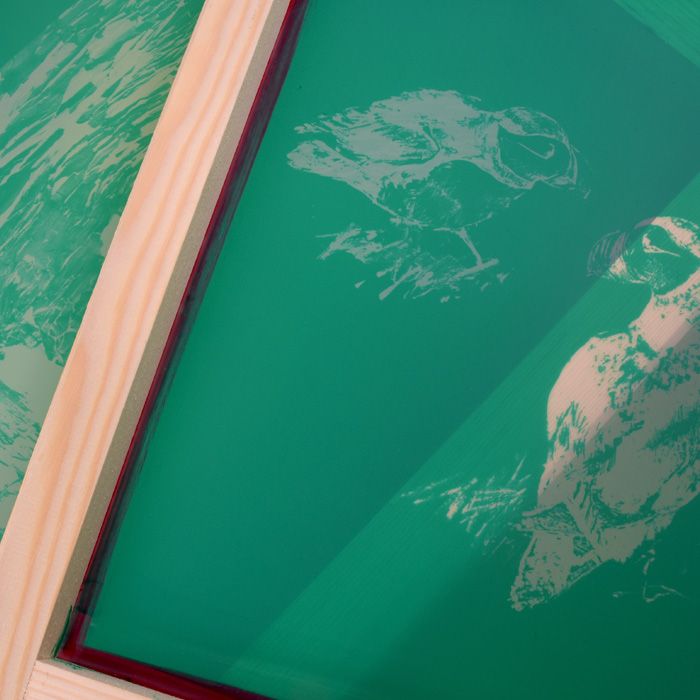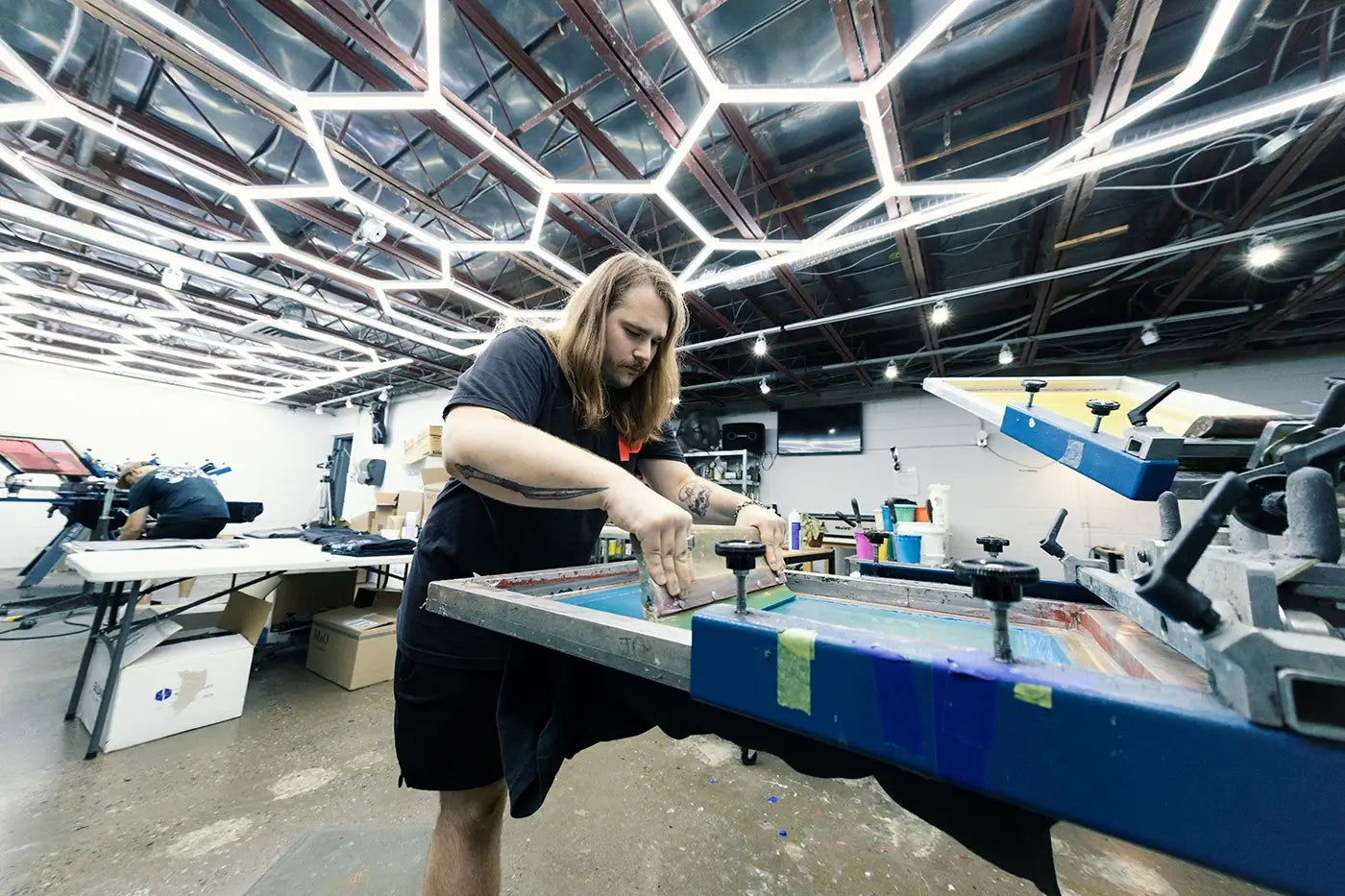Affordable Custom Screen Printing Services for Small Businesses
Affordable Custom Screen Printing Services for Small Businesses
Blog Article
Display Printing Uncovered: Everything You Required to Understand About Tee Shirt and Garment Printing Strategies
If you have actually ever before wondered exactly how those vibrant layouts end up on your preferred tees, you remain in the right place. Display printing is a fascinating method that integrates art with method, offering limitless opportunities for imagination. Comprehending the principles, from equipment to ink choices, can significantly impact your results. Prepared to check out the important elements that make screen publishing an art kind? Let's discover the details that can raise your jobs.
The Fundamentals of Screen Printing: Just How It Works
When you plunge into screen printing, you'll uncover it's both an art and a science. At its core, display printing involves creating a stencil, or screen, that allows ink to pass with only in particular locations.
Following, you'll mix your inks and prepare your printing surface area. Position the screen over the textile, then make use of a squeegee to push ink via the screen onto the garment. This procedure needs accuracy, as you want clear, vibrant prints. After printing, you'll heal the ink with heat, guaranteeing it abides by the textile and lasts with cleans. Each action is crucial, and understanding them will boost your screen printing skills, changing straightforward garments into unique, expressive pieces.
Sorts Of Display Printing Techniques
As soon as you understand the fundamentals of screen printing, it's time to check out the numerous strategies that can raise your styles. One preferred method is traditional display printing, where ink is pressed via a stenciled screen.
One more alternative is plastisol printing, understood for its toughness and dazzling shades, making it a preferred for many brands. Experiment with halftone printing to develop gradient impacts and complex layouts.
Essential Tools for Screen Printing
To achieve magnificent outcomes in display printing, having the right tools is essential. You'll need a strong display printing structure, which holds the mesh that moves your style onto the garment. Next off, spend in top notch squeegees; these are vital for using ink equally throughout the display.
Picking the Right Inks and Products
When choosing inks and products for display printing, you require to think about the type of ink that functions ideal for your task. Think of material compatibility to ensure your designs look terrific and last lengthy. Additionally, check out green ink options to make your printing procedure extra lasting.
Types of Screen Inks
Choosing the appropriate display ink is vital for accomplishing lively, resilient prints that meet your task's requirements. There are a number of kinds of display inks to take a look at. Plastisol ink is popular for its flexibility and convenience of usage, providing superb shade opacity on dark materials. Water-based ink, on the various other hand, uses a softer feel and is green, making it excellent for those aiming to reduce their ecological effect. Release inks remove color from the textile, leading to a soft, classic look but need specific handling. Specialized inks, such as glow-in-the-dark or metallic, can add special effects to your styles. Review your task requirements and choose the ink that aligns finest with your desired outcome.

Textile Compatibility Factors To Consider
Recognizing fabric compatibility is vital for achieving high-quality display prints, especially considering that various materials respond uniquely to numerous inks. Constantly check your inks on sample material to assure they adhere correctly and maintain color honesty. Furthermore, maintain in mind that material weight and appearance can impact the last outcome, so choosing the ideal ink and material combo is essential for your project's success.
Eco-Friendly Ink Options
Eco-friendly inks are coming to be a prominent selection for display printers who desire to reduce their ecological influence while maintaining high quality. When selecting inks, take into consideration water-based inks, which are less dangerous and easier to tidy up compared to standard solvents. These inks bond well with textiles, delivering dynamic outcomes without harmful chemicals. You may additionally explore eco-solvent inks that use less volatile organic compounds (VOCs), making them a much safer option for both your health and wellness and the earth.
In addition, try to find inks made from renewable energies, such as soy or vegetable-based options. By choosing the right inks and materials, you'll not only develop stunning designs but additionally add to an extra lasting printing procedure. Make the switch, and your prints will mirror your dedication to the setting!
Preparing Your Style for Screen Printing

File Style Requirements
To ensure your style looks sharp and dynamic on material, you'll require to pay very close attention to file style requirements for screen printing. Beginning with vector files like AI or EPS, as they can be scaled without losing high quality. If you use raster pictures, go with high-resolution files, such as TIFF or PNG, ideally at 300 DPI. Stay clear of utilizing JPEGs, as they can shed quality when resized. Make certain your design has a clear history to protect against undesirable white edges on your prints. Finally, keep color settings in mind; CMYK is basic for display printing, so convert your RGB makes as necessary. By adhering to these standards, you'll establish your artwork up for an effective print.
Shade Separation Techniques
Shade separation is an essential step in preparing your style for display printing, and mastering it can considerably improve your print top quality. You'll require to break your layout into individual shades, as each shade requires a separate screen throughout printing. This accuracy not only assures accurate shade representation but additionally simplifies the printing procedure.
Resolution and Size
Accomplishing the very best cause display printing starts with guaranteeing your design has the appropriate resolution and size. Ideally, your artwork should go to least 300 DPI (dots per inch) for sharp, clear prints. If you make use of lower resolution, your last item may look unprofessional and pixelated.
When it involves dimension, take into consideration the dimensions of your print area. Design your art work to match the last print dimension, preferably developing it in the actual dimensions you'll be printing. In this manner, you'll stay clear of any unforeseen scaling issues.
Constantly inspect your layout in both vector and raster formats. Vector graphics can be scaled without losing high quality, making them ideal for display printing. Preparing properly will assure your style looks fantastic on every garment!
Step-by-Step Screen Printing Refine
Screen printing is a dynamic process that permits you to create vivid layouts on various surface areas. To begin, you'll need a display, emulsion, and your picked ink. Prepare your screen by cleaning it extensively. Next, apply the emulsion uniformly and allow it completely dry in a dark location. Once dry, subject your display to light with your style put on it, which will set the solution where the light hits, creating a pattern - screen printing kit.
After washing out the unexposed emulsion, your screen prepares. Establish it up on your printing surface and straighten your garment below it. Pour ink onto the screen and utilize a squeegee to push the ink via the pattern onto the textile. Lift the screen thoroughly and allow the print dry. Finally, treat the ink making use of warm to ensure resilience. That's it! You have actually effectively display published your design.
Tips for Effective Display Printing Projects
While you're diving have a peek at this site into your screen printing projects, keep in mind that prep work is crucial to success. Start by collecting all your products-- inks, garments, displays, and mops. A tidy workspace helps prevent undesirable errors, so clean up before you start.
Next, validate your artwork is high-resolution and properly sized for your garment. Examine your display for correct exposure and clean it extensively to prevent spots. When mixing your inks, adhere to the producer's standards to achieve the ideal uniformity.
During printing, use also pressure with your squeegee for constant results. Do not hurry; take your time to verify each print satisfies your standards. After printing, allow your garments completely dry completely before handling or packaging them.
Finally, constantly maintain a sample of your benefit future recommendation. In this manner, you can evaluate your progression and improve your methods with time. Happy printing!

Often Asked Concerns
The length of time Does It Take to Establish a Screen Printing Job?
Establishing up a display see this printing task typically takes around half an hour to an hour. You'll prepare the displays, mix inks, and change the press. The time differs based on complexity and experience, so remain arranged!
Can I Publish on Various Material Types Using the Very Same Strategy?
Yes, you can publish on various fabric kinds making use of the exact same method, however you'll need to adjust your settings and inks. Some textiles take in ink in a different way, so exploring guarantees the very best results for each and every product.
What Prevail Blunders to Avoid in Screen Printing?
When display printing, prevent common blunders like utilizing the wrong ink, ignoring proper direct exposure times, or avoiding pre-press checks. Constantly check your arrangement and preserve tidy displays to guarantee top quality results each time.
How Can I Properly Tidy and Maintain My Display Printing Tools?
To properly clean and preserve your screen printing devices, you should frequently wash displays with appropriate solvents, examine squeegees for wear, and ensure all tools are saved dry and dust-free. Consistency stops costly repairs and boosts performance.
Is Display Printing Eco-friendly Contrasted to Other Techniques?
Screen printing can be a lot more environmentally pleasant than various other methods, especially if you utilize eco-conscious materials and water-based inks. By selecting sustainable supplies and methods, you lower waste and reduce your influence on the planet.
Screen Printing Uncovered: Every Little Thing You Need to Know Regarding Tee and Garment Printing Strategies
At its core, screen printing involves developing a stencil, or screen, that enables ink to pass via just in particular locations. Position the screen over the material, then utilize a squeegee to press ink through the screen onto the garment. One prominent technique is typical display printing, imp source where ink is pressed through a stenciled screen.When selecting inks and materials for screen printing, you need to take right into account the type of ink that works best for your project.
Report this page